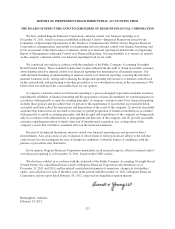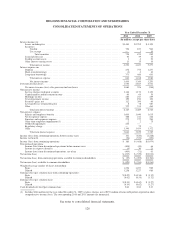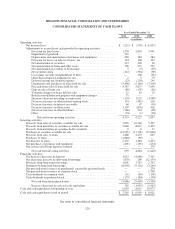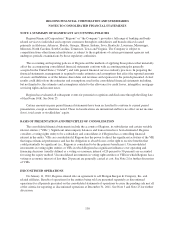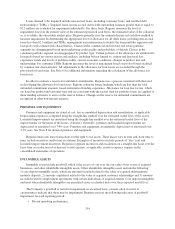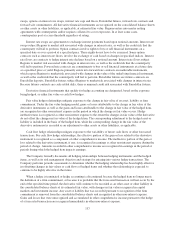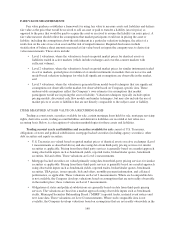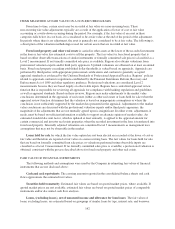Regions Bank 2011 Annual Report Download - page 156
Download and view the complete annual report
Please find page 156 of the 2011 Regions Bank annual report below. You can navigate through the pages in the report by either clicking on the pages listed below, or by using the keyword search tool below to find specific information within the annual report.The Company reviews its securities portfolio on a regular basis to determine if there are any conditions
indicating that a security has other-than-temporary impairment. Factors considered in this determination include
the length of time and the extent to which the market value has been below cost, the credit standing of the issuer,
Regions’ intent to sell and whether it is more likely than not that the Company will have to sell the security
before its market value recovers. Activity related to the credit loss component of other-than-temporary
impairment is recognized in non-interest expense. For debt securities, the portion of other-than-temporary
impairment related to all factors other than credit is recognized in other comprehensive income. See Note 4 for
discussion and details of other-than-temporary impairment.
LOANS HELD FOR SALE
At December 31, 2011 and 2010, loans held for sale included commercial loans, investor real estate loans
and residential real estate mortgage loans. Commercial and investor real estate loans held for sale consist of
certain non-performing loans for which management has the intent to sell in the near term. Regions classifies
new 15 and 30-year conforming residential real estate mortgage loans as held for sale based on intent, which is
determined when Regions enters into an interest rate lock commitment on this loan type. Regions has elected the
fair value option for residential mortgage loans held for sale. Residential real estate mortgage loans not
designated as held for sale are retained based on available liquidity, interest rate risk management and other
business purposes. Commercial and investor real estate loans held for sale are carried at the lower of cost or
estimated fair value. See the “Fair Value Measurements” section below for discussion of determining fair value.
Gains and losses of non-performing commercial and investor real estate are included in other non-interest
expense as such amounts are viewed as credit costs. Gains and losses on residential mortgage loans held for sale
for which the fair value option has been elected are included in mortgage income.
LOANS
Loans are carried at the principal amount outstanding, net of premiums, discounts, unearned income and
deferred loan fees and costs. Interest income on loans is accrued based on the contractual interest rate and the
principal amount outstanding, except for those loans classified as non-accrual. Premiums and discounts on
purchased loans and non-refundable loan origination and commitment fees, net of direct costs of originating or
acquiring loans, are deferred and recognized over the estimated lives of the related loans as an adjustment to the
loans’ effective yield, which is included in interest income on loans. See Note 5 for further detail and information
on loans.
Regions engages in both direct and leveraged lease financing. The net investment in direct financing leases
is the sum of all minimum lease payments and estimated residual values, less unearned income. Unearned
income is recognized over the terms of the leases to produce a level yield. The net investment in leveraged leases
is the sum of all lease payments (less non-recourse debt payments), plus estimated residual values, less unearned
income. Income from leveraged leases is recognized over the term of the leases based on the unrecovered equity
investment.
Commercial and investor real estate loans are placed on non-accrual if any of the following conditions
occur: 1) collection in full of contractual principal and interest is no longer reasonably assured (even if current as
to payment status), 2) a partial charge-off has occurred, unless the loan has been brought current under its
contractual terms (original or restructured terms) and the full originally contracted principal and interest is
considered to be fully collectible, or 3) the loan is delinquent on any principal or interest for 90 days or more
unless the obligation is secured by collateral having a realizable value sufficient to fully discharge the obligation
and the loan is in the legal process of collection. Factors considered regarding full collection include assessment
of changes in borrower’s cash flow, valuation of underlying collateral, ability and willingness of guarantors to
provide credit support, and other conditions.
Charge-offs on commercial and investor real estate loans are primarily based on the facts and circumstances
of the individual loan and occur when available information confirms the loan is not fully collectible and the loss
132



